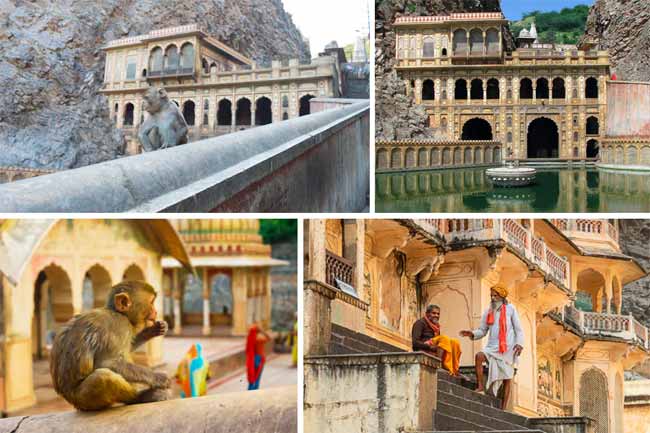Nestled amidst the rugged Aravalli Hills, just 10 kilometers east of Jaipur, lies the ancient and revered Galta Ji Temple, often affectionately known as the “Monkey Temple” due to its lively primate residents. This sprawling Hindu pilgrimage site is a captivating blend of natural beauty, architectural grandeur, and deep spiritual significance, offering a unique experience for both devotees and curious travelers.
A Glimpse into History and Architecture:
Dating back several centuries, with some beliefs placing its origins over 3000 years ago, the current structure of Galta Ji Temple is largely attributed to Diwan Rao Kriparam, a courtier of Sawai Jai Singh II, who oversaw its construction in the 18th century. Unlike conventional temples, Galta Ji boasts a design more akin to a grand palace or ‘haveli’, built predominantly from the characteristic pink sandstone of Jaipur. Its intricate carvings, detailed frescoes, rounded roofs, and sculpted pillars tell tales of Hindu mythology and showcase the artistic brilliance of the era.
The Sacred Kunds and Natural Springs:
The heart of the Galta Ji complex lies in its natural spring, which emerges high on the hill and gracefully cascades down, filling seven sacred water tanks, known as kunds. The most revered among them is the Galta Kund, believed to be a perennial source of holy water that has never dried up. Pilgrims flock here, especially during festivals like Makar Sankranti, to take a purifying dip in these sacred waters, believing it cleanses them of sins and offers healing properties. The water is channeled through a rock formation shaped like a cow’s head, known as ‘Gaumukh‘, adding to the mystical aura of the place.
The Enigmatic Monkeys:
The temple’s nickname, “Monkey Temple,” is well-deserved, as it is home to a thriving population of rhesus macaques and langurs. These intelligent and playful creatures roam freely throughout the complex, often interacting with visitors. While their antics are a source of amusement, it’s advisable to observe them from a safe distance, avoid direct interaction, and certainly refrain from feeding them openly, as they can be mischievous and snatch belongings. Their presence adds a vibrant, wild element to the serene spiritual atmosphere.
Spiritual Significance and Legends:
Galta Ji holds immense religious importance, particularly for followers of the Vaishnava Ramananda sect. It is primarily dedicated to Lord Hanuman, the monkey god, symbolizing strength and devotion. Legends abound about the site, including the belief that Saint Galav meditated here for many years, leading to the divine blessing of abundant water. Another popular belief suggests that Tulsidas, the revered poet, composed sections of the sacred Ramcharitra Manas at this very spot.
Best Time to Visit and Practical Tips:
The temple is open daily from 5:00 AM to 9:00 PM, with no entry fee for Indian nationals (though a nominal fee might be charged for foreign tourists, and a photography fee may apply, it’s best to confirm on arrival). The ideal time to visit is during the cooler months, from October to March, when the weather is pleasant for exploration. Early mornings or late afternoons are recommended to avoid crowds and experience the tranquil ambiance, with the added bonus of witnessing stunning sunrises or sunsets over the Aravalli hills from vantage points like the nearby Sun Temple.
When visiting, dress modestly as a sign of respect for the religious site. Comfortable footwear is advisable, as there’s a fair amount of walking involved. Carry water, especially during warmer months, and keep your belongings secure from the curious monkeys.
A visit to Galta Ji Temple offers a unique blend of spiritual immersion, historical exploration, and a chance to witness nature’s playful side, making it a truly memorable experience in the heart of Rajasthan.
